| 1 | Master of leafy forests |
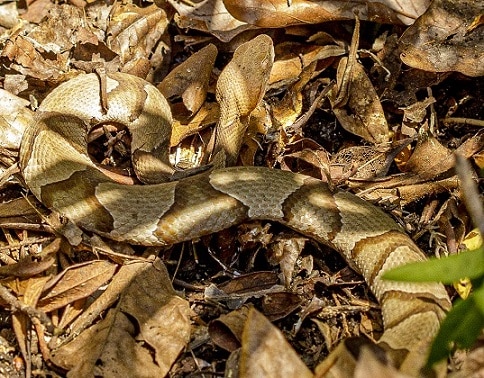
Copperheads are a byword for death in the eastern United States. This species ranges from Texas in the west to Virginia in the northeast, and in every state they inhabit, they leave a trail of nightmares and superstition in their wake. Every American knows about this venomous woodland menace, and for once, the terror quotient they generate is borne out by the facts.
Between 1983 and 2008, over 14,000 copperhead bites were reported to US poison centres. In 2014 alone, 1809 bites were reported, and that’s only the cases which came to doctors’ attentions.
Copperheads are easily recognisable by their large blotches, which resemble wonky hourglasses. They have vertical pupils, and a bulky head which is far thicker than their neck. They have no real lookalikes in the USA, except maybe the corn snake, which is red-orange in the wild, but significantly thinner. With their patterns closely resembling fallen leaves, the copperhead may have the greatest camouflage of any US snake, particularly on autumnal woodland floors, where they can be almost invisible.
Far from being a murderous maniac, the copperhead’s most common course of action is to “freeze” when confronted. As ambush predators, they don’t want to disrupt their own disguise, but this has the inadvertent effect of causing people to step on them, and that’s when things turn ugly. Copperheads belong to the same Agkistrodon viper genus as the cottonmouth, but are much more land-dwelling, rather than a semi-aquatic swamp snake.
| 2 | Lazy until June |
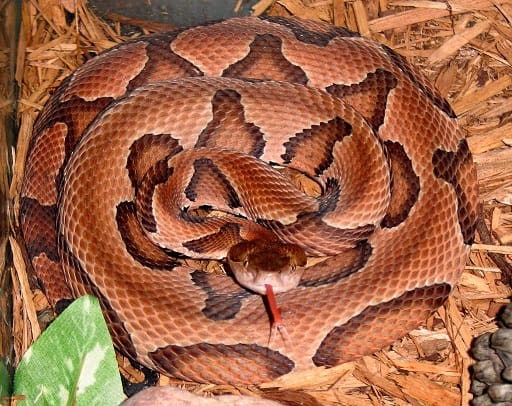
Copperheads are particularly common in mixed woodlands and deciduous forests, particularly those with a decent amount of rock outcrops. Copperheads hibernate in natural crevices or limestone rock cracks. When they emerge in March, they stay sluggish for a couple of months, moving 3-4 metres per day, staying close to their hibernation den.
In June, they suddenly rev up, and can migrate 200-300 metres to summer feeding grounds. Their life then consists of choosing the optimal ambush spot, perhaps with signs of well trodden mammal trails, and waiting for their prey to arrive, while keeping immensely still.
One study from Connecticut found that in April, copperheads moved an average of 4.14 metres per day. This increased to 20.76 metres in June, while the most active months were August and September, moving 33.16 and 32.66 m/day respectively. It’s rare for copperheads to climb, but they’ve been spotted up to 5 metres above ground. Copperheads also appear in forested swamp land occasionally, and they never appear in open areas like grassy fields and swaying crop fields.
| 3 | The cucumber smell (and more myths) |

Copperheads have a particularly high amount of superstitious folklore to wade through, until the truth becomes buried, if it was ever known in the first place. One is that an angry copperhead produces a cucumber smell. The legend goes that if you’re fixing your car’s wheels with a spanner, sipping from a cold beer, and cucumber wafts out from the woods outside your house, then drop your tools and get inside instantly, because an angry copperhead is imminent. In reality, copperheads produce a defensive musk like many snakes. But this smells nothing like cucumber, except maybe one 6 months past its sell date and covered with grey mould. The smell is designed to deter predators, and produced in times of stress.
Another funny belief is that young copperheads are more dangerous. Not because their venom is stronger, but because “they can’t control how much venom they release”. This is absolute rubbish – venom yield correlates to size, and therefore juveniles will release less. The no control theory was probably born at 1am by Louisiana old timers in a bar.
That said, there’s a handful of viperids, such as Bothrops moojeni, where hatchlings do produce a deadlier venom, with a different toxin profile. Another belief is that copperheads always travel in pairs. In reality, they’re a solitary species which only gathers together in mating season.
| 4 | Surprisingly reluctant to bite |
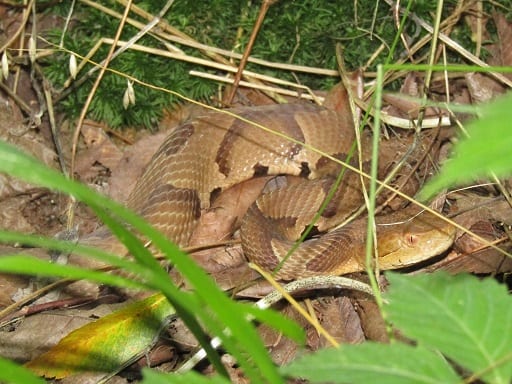
Copperheads are characterised as vicious killers or surprisingly docile forest creatures which just want to be left alone. A 2020 study tested its personality using science. It found that of 69 copperhead encounters, just two (3%) ended in an attempt to bite. Two copperheads postured and made mock bites.
The study involved 10 locations within Maryland, and took place during the copperhead’s active season of May 1st to November 1st. They used three trials. The first was an apparatus with a human boot attached to the end, placed directly next to the copperhead. In trial 2, the boot contraption was placed gently on the snake, to simulate somebody accidentally stepping on one. In trial 3, the copperhead was picked up, using a pair of tongs with a glove attached to the end.
Despite these detailed methods, the copperheads rarely struck. Five copperheads of the 69 vibrated their tails, and several fled into the undergrowth, with no desire to fight. Four (6%) of the copperheads showed no reaction whatsoever, even when picked up. Tail vibrating is a classic trick in copperheads, as when it strikes leaves, it produces a buzz like a rattlesnake. A copperhead can swish its tail 40 times in one second.
| 5 | Even dead ones can bite |
One freaky fact about copperheads is that even dead ones can inject venom. The story concerned a 23 year old man who met a copperhead in the wild. He slashed the copperhead into 3 separate pieces, leaving it completely and utterly dead. The young man gripped the corpse’s head, thinking the danger had passed. But a single fang accidentally penetrated his right index finger, and 1 hour later, his arm was becoming swollen.
At hospital, the man was given four vials of CroFab antivenom, but the swelling worsened, along with spontaneous bruise formation (ecchymosis). The doctors administered four new vials of antivenom, and after transferal to a new hospital, he received another two, bringing the total to 10 vials. By hospital day 2, the swelling had decreased, but a haemorrhagic zone had appeared on his right index finger, which was now black like a frostbite victim’s. By day 3, the man had recovered. He left hospital, and was not heard from again.
Never pick up a dead copperhead and boast of your glorious conquest. While shocking, this phenomenon isn’t new: rattlesnakes can inject venom after being shot multiple times (like any good horror villain). A more positive curiosity is that copperheads cause a particularly high number of dry bites – bites where no venom is injected.
| 6 | Specialises in tissue destruction |
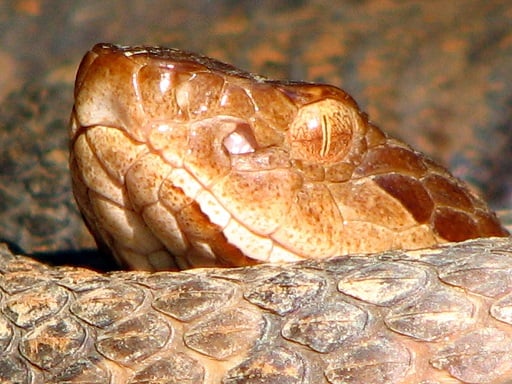
Copperheads aren’t renowned for symptoms connected to brain signal disruption like paralysis, laboured breathing, or drooping eyelids. Their symptoms are largely local, including extreme pain, swelling and damage to the bone if the bite lands on area with little flesh (hands and feet). The most common systemic symptom is nausea.
A study investigated copperhead venom in detail. It found that phospholipase A2s were the most abundant toxin class, comprising nearly 50% of total proteins. These have varied effects including neurotoxic, hemotoxic, and cytotoxic, though copperheads cause very few neurotoxic symptoms. The second most abundant were metalloproteinases (25%), which are common in fellow viperid venoms, particularly in rattlesnakes. Metalloproteineases have varied effects, but particularly cause local tissue destruction and spontaneous bleeding, via the destruction of clotting factors such as fibrin and fibrinogen. They also inhibit platelet aggregation, the small colourless cells which bind to together and plug wounds in the early stages of healing.
Despite this toxin arsenal, copperheads cause spontaneous haemorrhaging far less often than other vipers. Whatever hemotoxins they possess are evidently milder. There’s always exceptions though – this 52 year old woman experienced gastrointestinal bleeding after a nasty copperhead bite.
| 7 | Newborns have green tails |
Copperheads average at 60-95cm. The alltime record was 134.6cm, and a close contender measured 132.1cm. This makes them medium length for the Agkistrodon viper family. Cottonmouths reach a record 189.2cm, while the dangerous Taylor’s cantil (Mexico) maxes out at 96cm. That said, copperheads compensate for their short length with a bulky body, which is far thicker than a coral snake’s. This relates to their ambush lifestyle, and allows them to knock over prey with a crushing weight.
One hidden feature of copperheads is a brightly green tail in newborns, amid a sea of orange. The goal here is caudal luring – when snakes wave a bright tail to lure in curious insects and mammals, which they then ambush. Supposedly, the tail is designed to mimic caterpillar movements. The bright colouring remains until age 3 or 4. Adults apparently don’t need it – one explanation might be a larger strike distance, leaping further towards prey.
Many snakes become duller, less colourful with age, like the red-necked keelback, but copperheads are the opposite (except the tail). They begin as an unspectacular grey-brown. They have the same adult patterns, but only bloom into majestic woodland orange after a couple of years.
| 8 | Deaths are extremely rare |
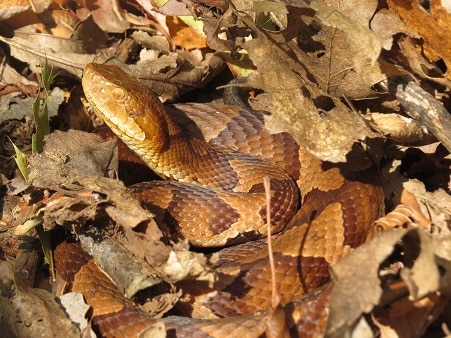
Copperheads are the number one cause of snakebite in the US, with their love for leafy woodlands where dog walkers often venture. That said, it’s very rare for a copperhead to kill. In 2016, there were 2048 confirmed copperhead bites, yet none were fatal. 94% ended in moderate to low level symptoms. Another estimate is that 2920 people are bitten annually, with just 0.01% resulting in a fatality.
Official lab results reveal one of the weakest venoms of all pitvipers. The LD50 toxicity score is 10mg, which pales next to the cottonmouth at 2mg, which is itself milder than an eastern diamondback rattlesnake (1.2mg) or eastern coral snake (0.2mg).
A copperhead’s venom yield per bite is 40-75mg, with 100mg estimated to be fatal in humans. If you feel one bite, back off instantly! A double bite will drastically complicate matters. One rare death happened in 2004 to a 32 year old Alabama man, who was swimming in Saugahatchee Creek near Loachapoka, and was bitten once on each hand. Always be cautious, as any pitviper bite can have unpredictable consequences. In 2019, a 52 year old man who was bitten in Alabama (again) lost consciousness within 2 minutes, which is unusual for a copperhead. He was sent to intensive care, but died in two days.
| 9 | Divided into two species (2015) |
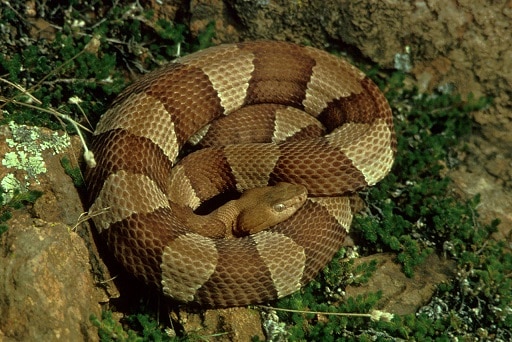
For decades, the copperhead had 5 official subspecies. These were…
- Northern copperhead (Agkistrodon contortrix mokasen).
- Southern copperhead (A. contortrix contortrix).
- Broad-banded copperhead (A. contortrix laticinctus).
- Osage copperhead (A. contortrix phaeogaster).
- Trans Pecos copperhead (A. contortrix pictigaster).
In 2015, this old consensus was shattered when genetic analysis revealed that there were no subspecies, and in fact two seperate species. The northern, southern and Osage copperheads had virtually no genetic difference to each other, and were synonymised under the flag of the original species: eastern copperhead (Agkistrodon contotrix). The Trans Pecos and broad-banded copperheads were genetically distinct from the remaining three, but had little difference to each other. Therefore, they became a new species, called the broad-banded copperhead (Agkistrodon laticinctus), which has been reconfirmed by genetic analysis since then. There are officially 2 copperheads on US soil as of 2023.
This new species lives further west than the main copperhead, reaching western Texas, and crossing into northern Mexico. Broad-banded copperheads are simple to distinguish, as their dark blotches are far straighter. They don’t narrow at the spine, removing the signature wonky hourglass effect.
| 10 | Connections to other snakes |
Copperheads are loners, but will occasionally share hibernation dens with members of other species, including timber rattlesnakes and eastern racers. With a flexible diet, they regularly eat fellow snakes as a small percentage of their diet. Confirmed species eaten include…
Ringneck snakes – at an average of 30cm, this harmless noodle is easy to slurp up. Found in woodlands beneath cover objects, often near copperheads.
Red belly snake – AKA Storeria occipitomaculata. A tiny snake at an adult range of 20-28cm. Likes moist woodlands and gardens.
Meanwhile, copperheads have been spotted being eaten by…
Common kingsnakes (Lampropeltis getula) – receives its name due to its ophiophagous (snake-eating) diet. Lampropeltis members are resistant to most pitviper venoms, allowing them to gulp down entire venom glands.
Eastern indigo snake – one of America’s longest snakes, at a record of 262.9cm. This species also lives in dry woodlands, and is confirmed to prey on eastern diamondback rattlesnakes. The copperhead looks like candy floss in comparison.
Black kingsnake – this Lampropeltis member is particularly common in Alabama, overlapping widely with copperheads.
